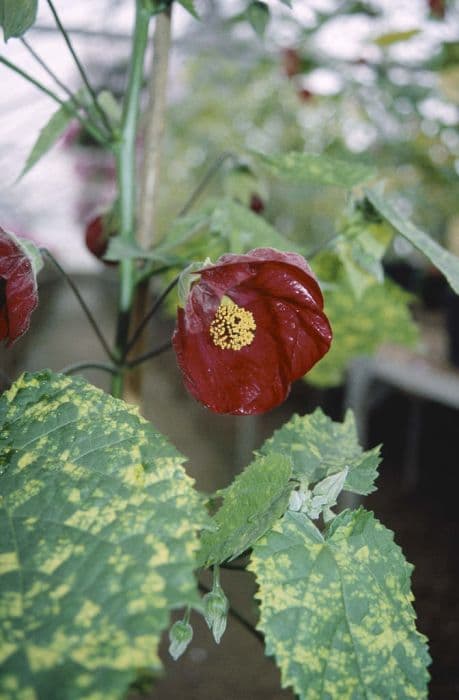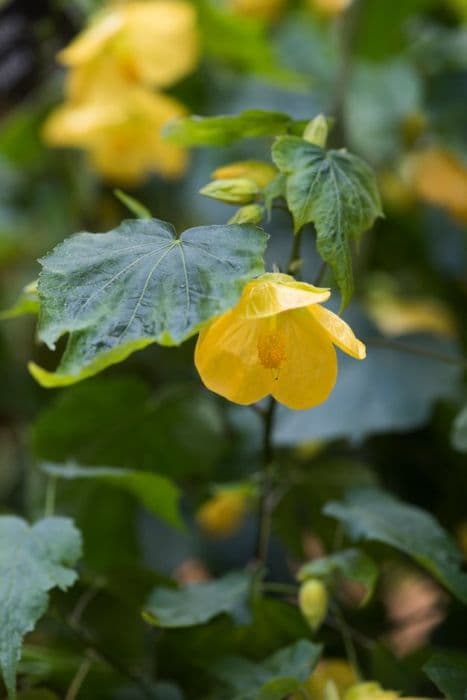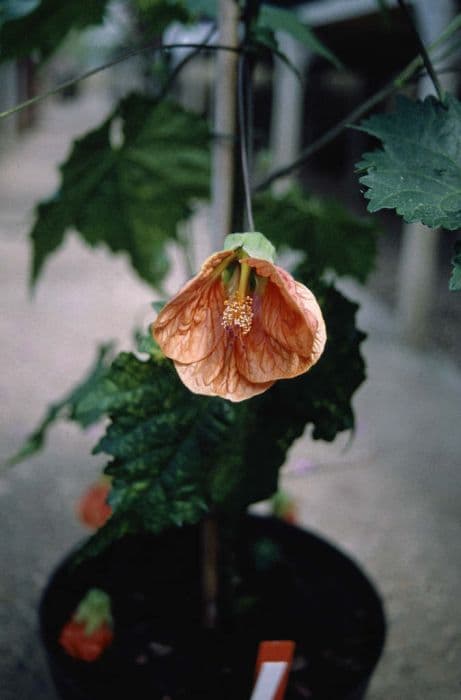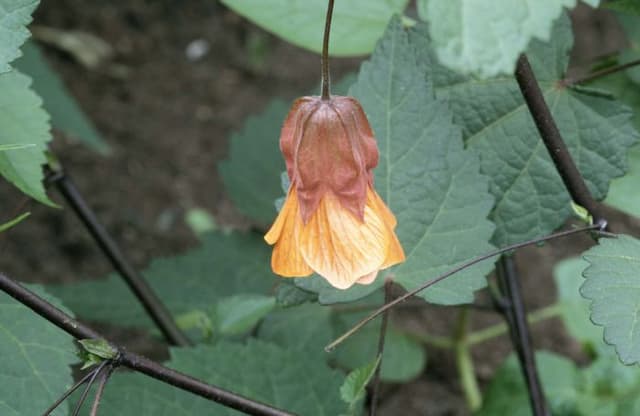Tree Mallow Lavatera × clementii 'Candy Floss'

ABOUT
Lavatera × clementii 'Candy Floss', commonly referred to as Candy Floss, is a strikingly beautiful plant known for its abundance of delicate blooms. This plant produces large, funnel-shaped flowers that exhibit a soft pink hue, reminiscent of the sugary fairground treat it's named after. The petals of Candy Floss are gently ruffled at the edges adding to its whimsical charm. Nestled at the center of each flower, one would find a contrasting darker pink to purple throat, creating a lovely depth and dimension to the overall floral display. The leaves of Candy Floss are equally attractive, being a rich mid-green color and having a somewhat rounded yet slightly lobed shape that gives the foliage a crinkled appearance. These leaves are arranged alternately along the stems, providing a lush backdrop for the prolific flowering spectacle. Candy Floss has a bushy and upright growth habit, presenting a dense and leafy structure where its brightly colored blossoms seem to almost float above the foliage. The contrast between the vibrant blooms and the greenery heightens the visual appeal of this plant. Overall, Candy Floss is characterized by its showy flowers and its ability to create a soft, romantic atmosphere in any garden setting where it is placed.
About this plant
 Names
NamesFamily
Malvaceae
Synonyms
Tree Mallow, Rose Mallow, Shrubby Mallow, Bush Mallow
Common names
Lavatera × clementii 'Candy Floss'.
 Toxicity
ToxicityTo humans
Lavatera 'Candy Floss' is not commonly listed among toxic plants, indicating no significant toxicity to humans. If any part of the plant were ingested, it's not expected to cause poisoning or severe symptoms. However, as with any plant not typically consumed, individual allergies or sensitivities could potentially cause mild gastrointestinal upset or other allergic reactions.
To pets
Lavatera 'Candy Floss' is also not known to be toxic to pets. Ingestion of the plant should not lead to serious poisoning. Nevertheless, it is generally recommended to prevent pets from eating ornamental plants as they could cause mild stomach upset or an allergic reaction in more sensitive animals.
 Characteristics
CharacteristicsLife cycle
Perennials
Foliage type
Semi-deciduous
Color of leaves
Green
Flower color
Pink
Height
5 feet (1.5 meters)
Spread
4 feet (1.2 meters)
Plant type
Shrub
Hardiness zones
6
Native area
Mediterranean
Benefits
 General Benefits
General Benefits- Attracts Pollinators: It is attractive to bees, butterflies, and other beneficial insects, which helps pollinate surrounding plants.
- Easy to Grow: Known for being low maintenance and easy to care for, making it a good choice for gardeners of all levels.
- Drought Tolerant: Once established, the plant has good drought tolerance, reducing the need for frequent watering.
- Fast Growing: Provides quick coverage due to its rapid growth, ideal for new gardens or filling in spaces.
- Long Blooming Period: The plant has a long flowering season, offering continuous blooms from summer to early autumn.
- Aesthetic Appeal: With its pink flowers, it adds a splash of color to any garden landscape.
- Adaptable to Soil Conditions: It can grow in a variety of soil types, although it prefers well-drained soil.
- Wildlife Habitat: Can provide shelter and nesting sites for small wildlife.
 Medical Properties
Medical PropertiesThis plant is not used for medical purposes.
 Air-purifying Qualities
Air-purifying QualitiesThis plant is not specifically known for air purifying qualities.
 Other Uses
Other Uses- Lavatera 'Candy Floss' can be used as a natural fabric dye, offering a range of soft pink hues to textiles depending on the mordant used.
- The stems of the plant can be woven into small decorative baskets or used in crafting for their fibrous qualities and strength.
- Dried Lavatera 'Candy Floss' flowers can be utilized in potpourri mixes, contributing a pink color and adding volume to the mixture.
- The plant can serve as a living fence or privacy screen in the garden due to its dense growth and height.
- Lavatera 'Candy Floss' can be used in educational settings to teach students about pollination, as it attracts bees and butterflies.
- The flowers and buds can be candied and used as decorative edible garnishes on cakes and desserts.
- Dried petals of Lavatera 'Candy Floss' can be incorporated into handmade paper, creating a unique texture and adding visual interest.
- The plant can be grown as part of a wildlife garden to offer food and habitat for native species.
- Lavatera 'Candy Floss' can be used in landscape photography as an attractive feature due to its large, showy blooms.
- Its rapid growth and sizable foliage allow Lavatera 'Candy Floss' to be planted in areas needing quick coverage or beautification of barren spots.
Interesting Facts
 Feng Shui
Feng ShuiThe Tree Mallow is not used in Feng Shui practice.
 Zodiac Sign Compitability
Zodiac Sign CompitabilityThe Tree Mallow is not used in astrology practice.
 Plant Symbolism
Plant Symbolism- Innocence - The Lavatera, also known as the Tree Mallow, bears delicate flowers that are often associated with the purity and innocence reminiscent of childhood.
- Rebirth - As a plant that can bloom abundantly and sometimes in cycles, the Tree Mallow can represent rebirth and the idea of starting anew.
- Sweetness - With the cultivar 'Candy Floss', this plant's symbolic meaning can extend to the notion of sweetness, both in terms of disposition and the enjoyable things in life.
- Softness - The soft, pastel colors of 'Candy Floss' blooms may convey softness, which can be linked to gentle emotions, tenderness, and empathy.
- Protection - Traditionally, mallows have been considered plants of protection, where their growth was believed to shield homes from harm.
 Water
WaterTree Mallow should be watered thoroughly, ensuring the soil is moist but not waterlogged. During the growing season, water the plant when the top inch of soil feels dry to the touch, typically once every week or two, depending on weather conditions. Provide about 1-2 gallons of water per watering session, reducing frequency in cooler months. Adjust based on rainfall and check more frequently during hot or windy weather as the soil dries out faster.
 Light
LightTree Mallow thrives in full sun, which means it needs at least 6 hours of direct sunlight per day. The best spot for this plant is in an area where it will receive unobstructed sunlight for the majority of the day. However, in regions with very intense sun, some afternoon shade can be beneficial to prevent scorching.
 Temperature
TemperatureTree Mallow is best suited for temperatures ranging between 50°F and 85°F. The plant can handle temperatures as low as 20°F for short periods, but it is more comfortable when above freezing. Ideal growing conditions are warm days and cooler nights.
 Pruning
PruningTree Mallow should be pruned to shape the plant, encourage bushier growth, and remove any dead or damaged stems. Pruning is best done in late winter to early spring before new growth starts. Cut back to just above a healthy bud, and aim to remove up to one-third of the plant to keep it vibrant.
 Cleaning
CleaningAs needed
 Soil
SoilTree Mallow 'Candy Floss' prefers well-draining, fertile soil with a pH range of 6.0 to 7.5. A good soil mix can be created using equal parts of garden loam, peat moss or compost, and sharp sand to ensure proper drainage.
 Repotting
RepottingTree Mallow 'Candy Floss' typically does not require frequent repotting and can be done every 2 to 3 years. It's best to repot if the plant becomes root-bound or the soil quality has deteriorated.
 Humidity & Misting
Humidity & MistingTree Mallow 'Candy Floss' is tolerant of a wide range of humidity levels but thrives best in moderate conditions. Excessively high humidity can lead to fungal problems, so adequate air circulation is important.
 Suitable locations
Suitable locationsIndoor
Provide bright light, well-draining soil, and water sparingly.
Outdoor
Plant in full sun, shelter from strong winds, enrich soil.
Hardiness zone
7-9 USDA.
 Life cycle
Life cycleLavatera × clementii 'Candy Floss', commonly known as Tree Mallow 'Candy Floss', begins its life cycle when seeds are sown in spring after the last frost has passed. The seeds germinate and soon give rise to seedlings, which develop a primary root system and a set of true leaves. As the plant grows, it enters the vegetative stage, producing a robust stem and a lush foliage of soft, heart-shaped leaves. This is followed by the flowering stage in the summer, when 'Candy Floss' shows off its characteristic large, pink blooms that attract bees and butterflies. After pollination, the flowers develop into seed capsules, which eventually dry and release seeds to complete the cycle. In colder climates, the Tree Mallow 'Candy Floss' may die back in winter, but it can re-sprout from the base in spring if the roots are well-protected.
 Propogation
PropogationPropogation time
Spring-Early Summer
Lavatera × clementii 'Candy Floss', commonly known as Tree Mallow 'Candy Floss', is best propagated through semi-ripe stem cuttings during late summer. To do this, select a healthy, non-flowering stem and cut a length of about 4 to 6 inches (10 to 15 centimeters). The cutting should be taken just below a leaf joint, where you should remove the lower leaves. Dip the cut end into a rooting hormone powder to encourage root growth. Plant the cutting in a pot filled with a mix of peat and perlite or a gritty compost, ensuring that the remaining leaves are above the surface. Keep the pot in a warm environment with indirect light and maintain the moisture of the potting mix without waterlogging. Roots typically develop in several weeks, after which the rooted cuttings can be transplanted into individual pots or into the ground.





![Abutilon [Yellow Trumpet]](/_next/image?url=https%3A%2F%2Fplants-admin.emdemapps.com%2Fimages%2Fplants%2F%2Fimages%2F604b5caa8b4fb.png&w=640&q=75)


